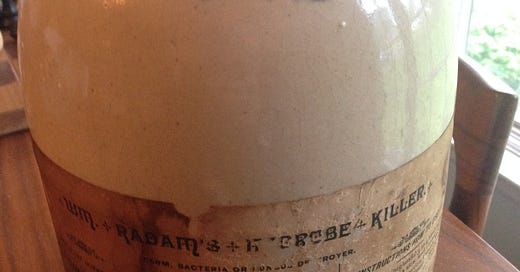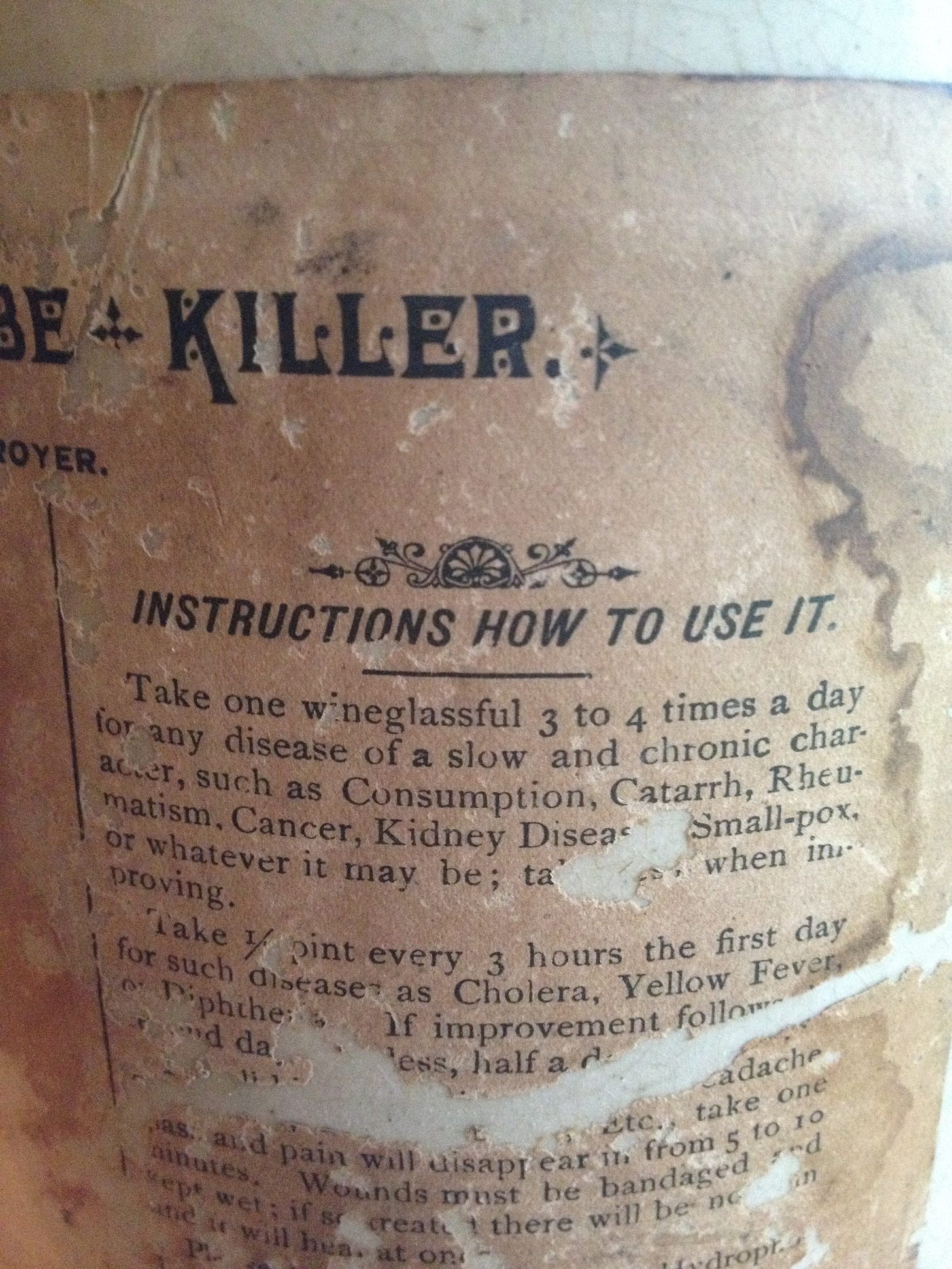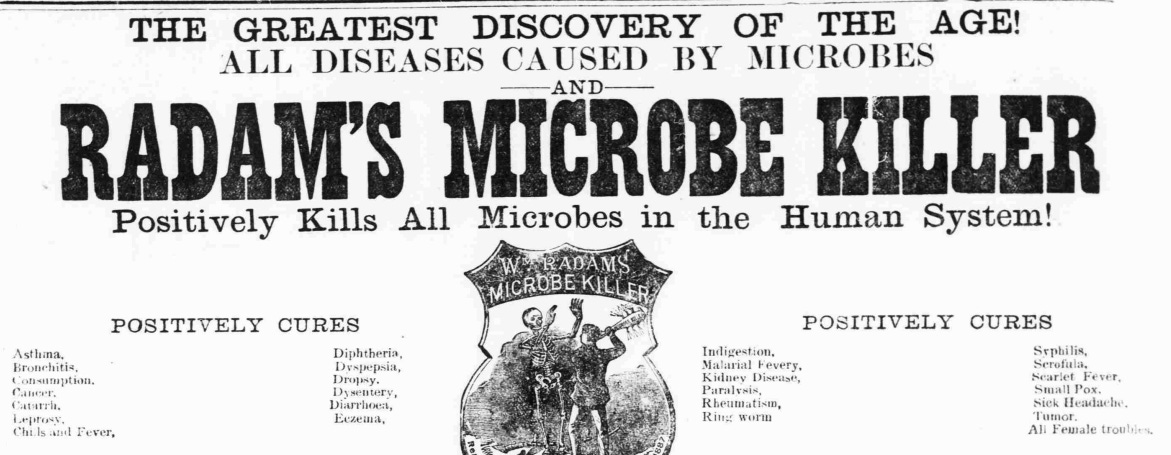Let’s set the scene, 2017: As my dad lays dying in the den of the house I was raised in, my daughter interviews him about his parents’ native Denmark for her family-heritage school project. It’s not a pretty picture but it’s real life—and real life ending. Like most anyone who lives long enough, he has cancer and once you get as far as giving up on the medicine/succumbing to hospice, you basically starve to death, as I learned once by watching my grandmother and now my dad. He’s always been a man who wants to leave a legacy of stories-remembered, so his granddaughter taking notes by this makeshift bedside is for him as much as us.
Meanwhile my brother and I are tackling all the nooks and crannies of the house, dividing up which half each will unhoard, he in the basement with the man tools and machines, me upstairs in the women’s-work realm of bread ties, yogurt containers, and impossibly dated canned goods. From the basement world rises up this bottle, which I photograph on the dining table.
And then get in closer to capture what remains of the label.
Minus some ellipses where I can’t fill in the gaps of the worn paper, here’s what I can decipher from Wm Radam’s Microbe Killer No. 2 - Instructions How to Use It:
Take one wineglassful 3 to 4 times a day for any disease of a slow and chronic character, such as Consumption, Catarrh, Rheumatism, Cancer, Kidney Disease, Small-pox, or whatever it may be; take less when improving.
Take 1/4 (?) pint every 3 hours the first day for such disease as Cholera, Yellow Fever or Diphtheria. If improvement following […] and pain will disappear in from 5 to 10 minutes. Wounds must be bandaged and kept wet; if so created there will be no pain and it will heal at once.
I was hoping I could fill in these word holes from some similar label online, but I found no such thing. Instead I did learn a good deal about this William Radam, these bottles, and this great lie that made him rich.
Some of these bottles are kicking around on Ebay, none of which have any label. I did find this listing on OldSoulAntiquesNSuch.com with the following history:
This antique stoneware jug once held William Radam’s famous “Microbe Killer” in No. 2 strength, which was the highest strength and is a wonderful piece of apothecary history.
A Prussian immigrant, Radam first patented his Microbe Killer in 1886 and began selling it by the jug not long after.
This jug is a survivor of that era!
Back in the 1880’s products that claimed to “cure all diseases” were called tonics, nostrums, or snake oil. Historians commonly refer to the colorful therapeutic products from that era as “quack medicine.”
One of the more distinctive characters of that era was William Radam, a gardener/botanist who formulated a microbe killer that claimed to “cure all diseases.” Wm. Radam, a contemporary of Pasteur, believed that all the ailments of the body were a result of microbial infestation of the blood and tissues. He experimented with a variety of chemicals to kill off these terrible bugs and patented his mixture in 1886.
The ingredients of said magic cure-all? “Sulfur, nitrate of soda, black oxide of manganese, sandalwood, chloride of potash, wine, pink dye and water.”
I am very curious about the proportions in this recipe, specifically this wine element, and was it enough to get drunk on, considering the fake doctor prescribes 3 to 4 wineglassfuls daily!
And guess who the No. 1 potion was for? Babies!
What I can’t figure out is where Radam’s own belief in his product ended (if anywhere) and the con-artistry began. It seems that Radam really thought, from his own experience with tuberculosis and recovery, that this concoction worked wonders—at least for him. As it got increasingly more popular, it seems the ad campaigns and the promises—and the money!—just got the better of him.
There’s a bestselling book that bolstered his claims with his own first-hand account of investigating the contents of his sick stomach, and from there of course forming the conclusion that microbes cause every problem known to humankind.
Cool art from the book cover featuring a man with a spiky baseball bat beating a skeleton:
And a good synopsis of the book from The National Library of Medicine:
In his book, Microbes and the Microbe Killer, William Radam made the “simple” statement that all diseases have a single origin: “There is, in truth, but one disease.” Based on this assumption, Radam marketed a single product, the Microbe Killer, which he claimed could cure every disease. Drawing on a combination of personal narrative, pseudo-scientific jargon, and emotional appeals, Radam used his book to market a product that cost virtually nothing to produce yet yielded significant profits.
The story behind this widespread advertising is reflective of both the direct experience and the cultural significance of tuberculosis in late nineteenth century America. As told by the author in his book, The Microbe Killer, Radam, as a sufferer of tuberculosis himself, grew disillusioned with the false promises of doctors and advertisements alike. By observing the contents of his stomach, he determined that there was only one type of microbe which caused all diseases. He became obsessed with finding a way to kill the microbes. To this end, he developed a product that he called the “Microbe Killer,” which he believed had cured him and would cure anyone who used it.
The advertising and marketing campaigns for Microbe Killer were successful because they appealed to a widespread fear of consumption. Radam created a sense of urgency by stating the dangerous microbe that caused all diseases was in everything that a person ate, drank, or breathed. He appealed broadly to the public by saying his cure was for everyone with consumption, including pregnant women and babies, as well as those sick with combinations of diseases.
As we well know, fear—when it’s not paralyzing—can be very compelling. If it doesn’t make you hide under a rock, it might induce an irrational spending spree. My bottle label says it will cure certain specific diseases of the day, but also: “whatever it may be” which is awesomely vague.
Under the “whatever it may be” category, I’ve found this newspaper ad below where the Killer “positively cures asthma, bronchitis, leprosy, chills and fever, dyspepsia, dropsy, dysentery, diarrhoea, eczema, indigestion, malarial fevery, kidney disease, paralysis, rheumatism, ring worm, syphilis, scrofula, scarlet fever, small pox, sick headache, tumor, all female troubles.”
Wait: not only fevery and things I’ve never heard of plus archaic spellings but also ALL FEMALE TROUBLES?!
Where would I even begin on the Female Troubles for which I need this pink-tinged elixir?
Can it help me with things physical or mental, quantifiable or invisible: a special brand of single-mom financial strain and the computer-induced daily malaise I have to muscle through in order to solve it, the perimenopausal irregularities that render me teenagery on the cusp of 50, the actual t(w)eenagers I clumsily navigate and the constant minor heartbreak of motherhood, the pangs of terror of imposterism every time I post a newsletter…?
I mean, maybe the Microbe Killer has a better chance of helping with all of that, at least temporarily, should this rotten old liquid (I did shake it to see) at least have any alcohol left in it. I’m not above taking a swig from something with chunks from the 1880s.
But cure cancer? I don’t think so.
Here we are in 2023 and we haven’t done that yet.
If my dad were here I’d ask him the story about this bottle.










My money is on you.
What a story. What a bottle. Sadly I'd be concerned it might not have had the preservatives to carry it through these many years, so caution would be advised. As far as cures for female trouble, and all other troubles go, how sad we've lost this great Miracle Cure. I wish your father was around to tell us how he got it too.